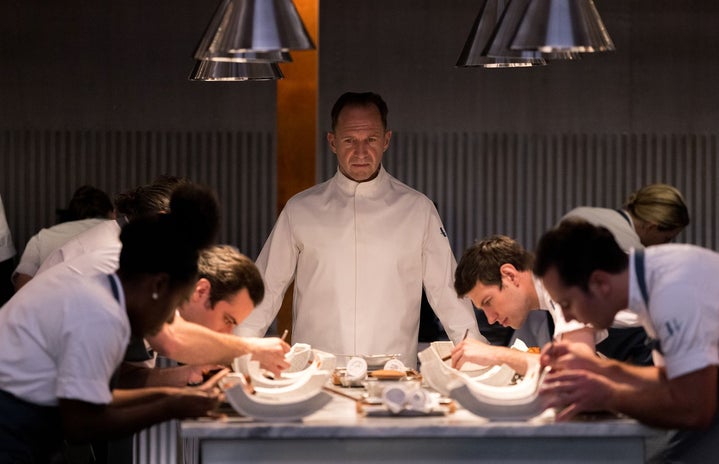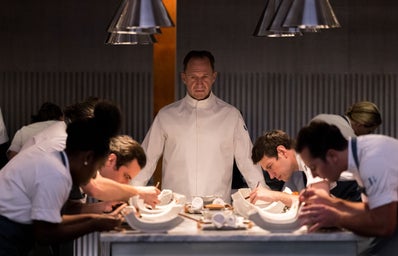The Menu offers a unique sampler to start off your night: the severed ring finger of an unfaithful husband, lightly toasted with a side of entitled finance bros. Personally, I don’t recommend the main dish: half-baked social commentary served by a homicidal chef with a big ego.
The Menu promises witty satire and exciting action, but it fails to provide cohesive criticism of its insufferable, wealthy characters. I came away from the film with a strong craving for a burger, but no appetite leftover to eat the rich.
The Menu is the newest addition to the family of films trying their hardest to critique the wealth gap between the working class and the wealthy 1%. Parasite (2019) did it (best!) with clever twists and artistic flair, but The Menu’s closer relative is Glass Onion (2022), a star-studded mystery thriller full of on-the-nose social commentary meant more to entertain than inspire class consciousness.
It’s not hard to catch on to the “Eat the Rich” mantra of The Menu. The plot follows Margot Mills (Anya Taylor-Joy) and her pompous date Tyler (Nicholas Hoult) as they dine in an exclusive restaurant led by acclaimed chef Julian Slowik (Ralph Fiennes). The other affluent diners are all introduced via their professions, each exemplifying a different capitalistic value, and their dehumanizing treatment of the kitchen staff. Margot is the only outlier, a professional escort who calls out Tyler’s snobbish behavior and rolls her eyes at Slowik’s pretentious dish introductions. When Slowik reveals the main course — his homicidal mission to kill every diner for their consumerist role in bastardizing the art of food — Margot must choose between joining his suicidal staff or aligning herself with the other diners.
At the end of the day, The Menu is shallow because it does none of the work to develop characters and encourage empathy.
To the annoying film over-analyzer (me), each character might represent a different quality of hierarchical class divisions. The finance bros, a trio of young people of color, show how any white-collar worker (even historically disadvantaged people of color) can be complicit in the exploitation of the working class. The restaurant’s militant hostess Elsa cries “You will not replace me” as she attacks Margot with a knife to represent how the working class can be divided by manipulative talking-heads, like Slowik. The kitchen staff obeys Slowik with hive-minded devotion and are repaid with their own willing deaths, exemplifying how service workers are treated as dispensable. But does all of this complicated analysis give The Menu more credit than it deserves?
At the end of the day, The Menu is shallow because it does none of the work to develop characters and encourage empathy for either side of the class division. It was lazy for the writers to never expand the diners beyond their worst and most superficial traits. Even when these characters were easy to hate, I sometimes felt better represented by the trio of finance bros or the washed-up movie star and his agent than Margot, since their minority status and flawed personalities made them more relatable than an edgy and mysterious Anya Taylor Joy. If The Menu wanted to drive home the point that essential workers are exploited and dehumanized, it should have let the kitchen staff voice their own opinions instead of turning them into Slowik’s cultish followers in his ego-tripping performance.
Slowik’s madness contradicts the idea that The Menu wants us to side with his philosophy. Plenty of screentime is spent on Slowik’s philosophical rants about how his capitalist clients have drained the love out of food. Whenever his childish attitude highlights his hypocrisy, it also discounts the credibility of his belief system. In doing this, The Menu is giving us permission to laugh at the spectacle of rich people on fire, as long as we abide by the fine-print: don’t try this at home, kids, or you might end up like this lunatic. So do the creators of The Menu really want us to eat the rich? Or do they want us to play into a shallow revenge fantasy without asking too many questions?
Not every movie needs a nuanced take on pressing social issues, but The Menu is so eager to show off its bloodthirsty caricatures that it feels more like a rich person’s parody of class consciousness than genuine commentary. Maybe I would be less offended if they hadn’t slandered s’mores.





